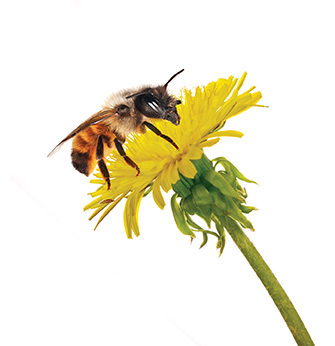Bees, Crops and You
By Ruben Alarcon, Assistant Professor of Biology
Most people are unaware of just how important bees are in their everyday lives. That apple you had for lunch is the product of bee-labor. What about steak? Yes that too; bees pollinate the alfalfa that is fed to cattle. Almost 90% of all flowering plants rely on animal pollinators for successful reproduction, and it is estimated that 75% of global crops benefit from insect pollination. Pollination is the movement of pollen from the anthers (male reproductive organs) to the stigma (female reproductive organs) of another flower for the purpose of fertilizing and producing seeds. Over 130 fruit and vegetable crops in the United States either require bee pollination, or greatly benefit from the action of bees and other insects.
Most crops in North America are commercially pollinated by the non-native European honey bee, Apis mellifera. Growers often contract with beekeepers to transport and maintain honey bee colonies in their orchards or fields to pollinate the crops. Every year 1.5 million honey bee colonies are trucked across the country to pollinate the 750 thousand acres of almonds in California’s Central Valley. This is the largest pollinator migration event in North America, if not the world!
However, declines in honey bee populations over the last several years due to Colony Collapse Disorder, parasitic mites, exposure to pesticides, and poor nutrition, have resulted in difficulties in securing pollination services. As more acreage is devoted to insect-pollinated crops, the costs associated with securing honey bee colonies will rise, not to mention the risk in relying on a single species to pollinate most of our crops. This has highlighted the need to characterize the role that native bees, such as bumblebees (Bombus sp.), leaf cutter bees (Megachile sp.) and mason bees (Osmia sp.), can play in agriculture.
As a pollination ecologist I study the interactions between insects and the flowers they visit. Over the last few years I have studied ways to maintain healthy honey bee populations, including the potential benefits of providing them supplemental forage, i.e., growing flowers specifically to feed honey bees. With the help of CI undergraduates, local growers and collaborators at the UC Cooperative Extension, I will embark on studies to determine how native bees can be used alongside honey bees to pollinate crops in Ventura County, including avocados and berries. Avocado orchards, for example, often require up to 6 honey bee colonies per acre to achieve successful pollination because avocados have a unique flowering system requires that pollen come from a different cultivar. Anecdotal evidence indicates that avocado orchards near natural vegetation require fewer honeybee colonies to achieve adequate pollination. This suggests that native bees might be providing "free" pollination services to growers. By making orchards more attractive to native bees, growers may be able to increase the pollination services that their crops receive, and potentially increase yields.
So the next time you bite into an apple, or that juicy steak, make sure to thank a bee!
